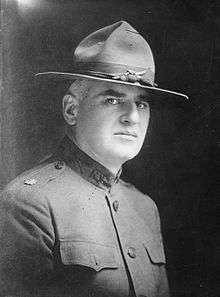George Fletcher Chandler
| George Fletcher Chandler | |
|---|---|
 | |
| Superintendent of the New York State Police | |
|
In office May 1, 1917 – December 1, 1923 | |
| Governor | Charles S. Whitman |
| Preceded by | Inaugural holder |
| Succeeded by | James Adams Warner |
| Personal details | |
| Born |
George Fletcher December 13, 1872 Clyde, New York, U.S. |
| Died |
November 6, 1964 (aged 91) Kingston, New York, U.S. |
| Spouse(s) | Martha Marie Schultze (1900–1931) (her death) |
| Alma mater |
Syracuse University Columbia University (M.D.) |
| Military service | |
| Allegiance |
|
| Service/branch |
|
| Unit |
|
George Fletcher Chandler, M.D. (December 13, 1872 – November 6, 1964), was a surgeon who organized the New York State Police in 1917 and served as its first Superintendent.[1]
Early life
Chandler was born in Clyde, New York to a Methodist minister. His early childhood was spent in Lockport, New York and Portland, Oregon.[2][1] He graduated from Ithaca High School in Ithaca, New York,[1] Syracuse University in 1892 and Columbia University College of Physicians and Surgeons in 1895.[3] While working as a physician, Chandler befriended Charles S. Whitman, a fellow young professional with whom he shared a rooming house.[4]
Chandler was also a talented violinist. In 1900, he married Martha Marie Shultze, the daughter of the founder of Syracuse University's School of Music. They had two sons, Daniel and Fehmer, before her death in 1931.[1]
Military and police career
Chandler enlisted in the New York National Guard as a lieutenant and, by 1916, had reached the rank of major.[3]
In 1917, shortly after returning from the Pancho Villa Expedition, Chandler was tapped by his friend and New York Governor Charles S. Whitman to head and organize the New York State Police.[3] Chandler initially declined the offer as he hoped to fight in World War I.[5] At the time, Theodore Roosevelt was raising a division to join the war effort. Chandler began organizing a constabulary only when Roosevelt promised him that he would later request its transfer to his division. However, Roosevelt failed a physical examination and the United States government declined to accept the Roosevelt division for duty.[6]
Following the collapse of the arrangement with Roosevelt, Chandler resolved to create the constabulary that Governor Whitman had charged him with. He visited and studied the Pennsylvania State Police and the Royal Northwest Mounted Police in Ottawa.[2]
Uncomfortable with the political pressure of his position, Chandler later offered his resignation.[2] In late 1918, Chandler left New York to serve with the U.S. Army Medical Corps at Fort Oglethorpe in Georgia.[3] He returned to his post as Superintendent in 1919, following Governor Whitman's refusal to accept his resignation.[3][2]
As Superintendent, Chandler was involved at every level of the state police and his impact on the organization was long-lasting. He began by filling the ranks of the force by recruiting men from the New York National Guard.[7] Chandler coined the term "New York State Trooper" and, contrary to the norms of the time, required that troopers carry their weapons exposed on the outside of their uniforms.[8] He instituted rigorous processes for screening, training and education of the force. Chandler also established the New York State School for Police, which emphasized legal training and became a standard for police forces in the United States.[3]
Retirement
On December 1, 1923, Chandler retired from the state police and established a surgical practice in Kingston, New York.[3][2] In retirement he served on New York's State Crime Commission in the governments of Alfred E. Smith and Franklin Delano Roosevelt. He died in 1964 at the age of 91.[1]
References
- 1 2 3 4 5 "George Chandler, Police Aide, Dies". New York Times. November 7, 1964. Retrieved 2015-09-06.
- 1 2 3 4 5 Kurek, Albert S. (2007). The Troopers Are Coming: New York State Troopers, 1917-1943. AuthorHouse. p. 10. ISBN 9781600080357. Retrieved 19 April 2017.
- 1 2 3 4 5 6 7 "Superintendent George Fletcher Chandler". www.troopers.ny.gov. New York State Police. Retrieved 19 April 2017.
- ↑ "NYSP History: 1917 to 1929 The Formative Years". www.troopers.ny.gov. New York State Police. Retrieved 19 April 2017.
- ↑ Kurek, Albert S. (2007). The Troopers Are Coming: New York State Troopers, 1917-1943. AuthorHouse. p. 9. ISBN 9781600080357. Retrieved 19 April 2017.
- ↑ Kurek, Albert S. (2007). The Troopers Are Coming: New York State Troopers, 1917-1943. AuthorHouse. pp. 9–10. ISBN 9781600080357. Retrieved 19 April 2017.
- ↑ Goderre, Frank (2007). New York State Police Troop K. Arcadia Publishing. p. 7. ISBN 9780738549828. Retrieved 19 April 2017.
- ↑ Miller, Wilbur R. (2012). The Social History of Crime and Punishment in America: An Encyclopedia. SAGE. p. 1230. ISBN 9781412988766. Retrieved 19 April 2017.